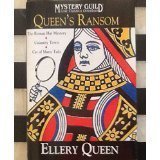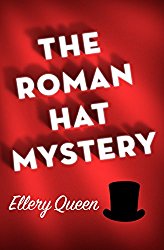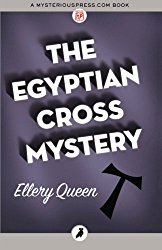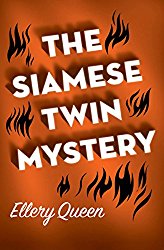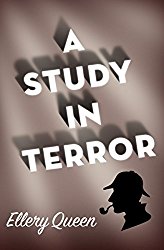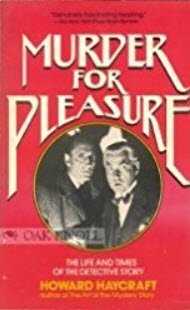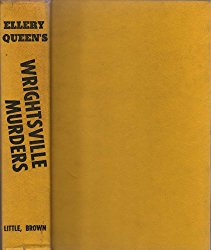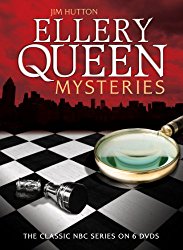Ellery Queen
"Ellery Queen is the American detective story."
-- Anthony Boucher
That the name Ellery Queen was a pseudonym of two men teaming as one writer was, for many years, kept from the public. But the germ that was to develop into Master Detective Ellery Queen incubated in the mind of at least one of the men since he was a child, and the infection spread to his cousin some time later.
When he was twelve years old, Frederic Dannay was sick. Nothing serious, just a childhood illness that kept him home from school for a day or two.
His mother brought him a book from the library to help him through his ordeal. This was to prove of momentous impact to the history and development of detective, crime, and murder mystery fiction, for the book was The Adventures of Sherlock Holmes, and the boy would never be the same again.
Some years later, Frederic Dannay and his cousin Manfred Lee decided to enter a contest sponsored by a magazine. To enter, contestants must write and submit a book-length manuscript. The winning manuscript would be published.
They won! But the magazine folded before being able to publish their book.
|
Click Image to Click the image below to |
Note: Queen's Ransom includes three Ellery Queen novels:
|
|
It was to prove of small consequence, for a book publisher was to publish their book -- The Roman Hat Mystery -- the first of many novels they were to write about their detective, Ellery Queen. Their concept was brilliant -- create a pseudonym (Ellery Queen), make it easy for readers to remember by repeating it throughout the book, and to do that simply give the detective the same name as the author. |
Click Image to Click the image below to |
With The Roman Hat Mystery, the template was set for the first decade or so of Ellery Queen murder mysteries. In it, we are introduced to the bachelor household:
- A young Ellery Queen, with all his early affectations (a cane, a monocle, and his oxymoronic brilliance contrasted to his attitude. One early passage claims, "He prided himself on a complete ignorance of the classics").
- Inspector Richard Queen -- Ellery's father, as well as his touchstone to the inner circle of New York City's police bureaucracy. This gives the amateur sleuth access to the professionals and, quite often, inside information.
- Djuna -- houseboy to the Queens.
In addition, we are introduced to J.J. McC -- who only writes the forewords for this first period of the Ellery Queen adventures. Mr. McC assures the public that Ellery Queen is alive and well, that Ellery is based on a real person though his name has been changed, and that he is married and living in a villa in Italy with his wife. (A decade later, this information seems forgotten, as Ellery Queen is to become so different from the earlier descriptions -- dropping his affectations, becoming involved in several romances, and the like -- that Julian Symons was to conclude that there were at least two different men who used the name Ellery Queen. Symons's interview with an amused Frederic Dannay was published in Great Detectives.
But other pieces of the Queen template were established as well, including the following:
- The titles of each book (in the initial period) would have an adjective and a noun, followed by the word "Mystery." (Hence, titles including the following appeared: The French Powder Mystery; The Dutch Shoe Mystery; The Egyptian Cross Mystery; The Chinese Orange Mystery; The American Gun Mystery; The Siamese Twin Mystery; and so on.)
- A Challenge to the Reader let the reader know that "Dear Reader, you are now in possession of all the clues and should be able to solve the mystery." (This is a paraphrase and conveys the gist of the challenge. In truth, each Challenge to the Reader was unique to the book for which it was written. One even intimated that more evidence would surface but that you, the reader, would find it unnecessary because you could solve the crime with the clues you already possessed!) The famous Challenge to the Reader appeared in a box at the appropriate place in each book.
|
Click Image to Click the image below to |
Click Image to Click the image below to |
Commentators, critics, reviewers, and fans agree that Ellery Queen mysteries are unique. The Ellery Queen books hang together so well -- the logic is so intricate -- that when Ellery Queen (the detective) reveals the murderer, it really can only be whoever Queen identifies. Other fictional sleuths often leave the reader in doubt. (I remember reading a mystery writer's advice to would-be authors once. The advice was to read a mystery, try to figure out who the culprit is, and if you're wrong then you've already got your plot and your own solution!) But one cannot do this with a Queen book, and subsequently Queen is referred to as "The logical successor to Sherlock Holmes." In this instance, the word "logical" refers to the fact that in a Queen plot one person, and only one person (unless it's a collusion where more than one person is involved in the crime) can "logically" be the criminal. The plots are absolutely airtight!
But Frederic Dannay and Manfred Lee didn't stop here. As they continued the Ellery Queen series, they contributed so much to the genre that it simply boggles the mind. Among their accomplishments are the following:
- The Hollywood Period. The Ellery Queen series of murder mysteries continued beyond the first period. Queen was to change as Dannay and Lee were brought to Hollywood to write screenplays. They developed novels as tie-ins to the films.
- The Wrightsville Period. Returning to the East Coast, Dannay and Lee made a serious attempt to create a new, more naturalistic type of detective story. They invented a town called Wrightsville, and Ellery Queen solved several mysteries here. One of these, Ten Days Wonder, was made into a film by Orson Welles (who used the plot but left Ellery Queen himself -- who was central to the plot of the book -- out of the film altogether).
- A Study in Terror -- Dannay and Lee were tapped to transform the screenplay for the Sherlock Holmes film into a novel. Although the film was about Holmes and had absolutely no reference to Ellery Queen, the novel they wrote include Queen at the core. Working under a deadline on one of his own books (Ellery Queen in the novels of this period was not merely a detective. He was a writer and was faced with constant deadlines), a friend came calling. Queen said he didn't have much time because he was working under a deadline, but his friend said his visit was very important. Queen's friend presented a manuscript that purported to be written by none other by John H. Watson, M.D. -- the man who wrote all but four of the Sherlock Holmes stories. (Two of the Holmes stories were written by Holmes himself, and two were in third-person.) Although faced with a deadline, Queen felt compelled to take up the case -- it seems a relative of the person who was revealed to be the criminal in this case (none other than Jack the Ripper himself) believed that Holmes got it wrong! Queen investigates and discovers -- warning: spoiler -- Holmes got it right. But Dr. John H. Watson, Holmes's famous biographer, misinterpreted Holmes's views when he wrote his manuscript. Queen exonerated the falsely accused man. (What a brilliant twist to the screenplay!)
- Anthologies. A number of indispensable anthologies reintroduced classic detective stories, murder mysteries, and crime stories that may well have been lost and forgotten had it not been for the Queens's diligence. Among these were Rogues' Gallery, which grouped fictional criminals in one place; another anthology which introduced Pulitzer Prizewinners who had written mysteries; Female criminologists and criminals; and my personal favorite -- Ellery Queen's Challenge to the Reader. This last book changes the name of the author and of the detective for each story that is included. The reader is challenged to figure out who the actual detective and who the real author are. This book introduced me to the detective Astro, and to others whom I had only read about previously.
- Ellery Queen's Mystery Magazine. This important magazine included in each issue at least one story by a previously unpublished author. It also included rare stories that Dannay and Lee had discovered, and which they introduced to the public. These included a detective story written by none other than President Abraham Lincoln, and President Woodrow Wilson's article "Holmes was an American."
- Prince Zaleski. The Queen anthologies, introductions, articles, and other sources introduced readers like me to the Prince Zaleski stories. (One of these is included in this website's FREE Reading Room.)
- The Haycraft-Queen Definitive Library of Detective, Crime, and Murder Mystery Fiction: A Reader's List of Detective Story Cornerstones. After Howard Haycraft published his classic Murder for Pleasure, which included a list of detective story cornerstones, Queen (actually, Frederic Dannay) approached him and urged him to produce a second, revised edition to include more recent books he felt destined to be classics (he was correct) and to ask if he could embellish Haycraft's list of cornerstones. The result included the list of cornerstones which many, many aficianados of detective story fiction (myself included) use as a guidepost to develop our personal libraries. This has been, and continues to be, an indisputable contribution to the continuation of the genre. This is the place to start when beginning one's collection.
- Ellery Queen radio programs. Dannay and Lee wrote a series of radio shows about Ellery Queen. It introduced Queen as "an American Sherlock Holmes," a versatile man, and a busy one. These radio programs included Nikki Porter -- Queen's secretary, who was introduced in the Hollywood period (first in films and then brought into the novels). Celebrities were invited to take up the famous Queen challenge and present a solution before a live audience. Queen would then reveal the true solution and explain why it was the "logical" one.
- Non-Queen novels. Dannay and Lee published other novels as well, including stories about Ellery Queen, Jr. These included...
- Drury Lane. Dannay and Lee invented character Drury Lane and created a new pseudonym -- Barnaby Ross. Lane was a retired actor from the stage who applied his art to life to solve crimes. Readers were unaware that Drury Lane and Ellery Queen were pseudonyms. What fun they must have had when they toured! Audiences were unaware that both authors collaborated under both pseudonyms. This made it possible for one cousin to pose as Queen and the other as Ross. They scripted their appearances to convince audiences that they were competitors, and they challenged each other to publicly solve mini-mysteries. Wouldn't it be grand if some of these appearances were recorded and survive? At this writing, I am unaware of any such recordings, but I would love to hear them if any become available.
- Dannay himself was a great collector of detective books and stories, including rarities.
- Somewhat disappointing is the fact that the cousins farmed out the last six to ten Ellery Queen books to other authors. I read two or three of these before I discovered this fact. Now that I know it, I realize why I was unenthralled with the ones I had read. The final three (of some forty books that they had written) remain on my library shelves unread, although many of the earlier ones I reread several times over. They also farmed out whole series of detective stories and novels (some are listed below).
- Ellery Queen short stories. These are not to be overlooked. They range from short-shorts of a page or two to classic attempts to solve, say, unwritten Sherlock Holmes cases with a highly-satisfying solution (as in the novelette "The Lamp of God," in which Queen solved the unwritten Sherlock Holmes case about James Phillimore, who was seen by witnesses to step back into his house and was never seen again).
|
Click Image to Click the image below to |
Click Image to Click the image below to |
You owe it to yourself to sample this remarkable series.
- The Roman Hat Mystery (1929) (Also available in The Ellery Queen Omnibus)
- The French Powder Mystery (1930) (Also available in The Ellery Queen Omnibus)
- The Dutch Shoe Mystery (1931)
- The Greek Coffin Mystery (1932)
- The Egyptian Cross Mystery (1932)
- The American Gun Mystery (1933)
- The Siamese Twin Mystery (1933)
- The Adventures of Ellery Queen (1933-1934)
- The Chinese Orange Mystery (1934)
- The Spanish Cape Mystery (1935)
- Halfway House (1936)
- The Door Between (1937)
- The Devil to Pay (1938) [The Hollywood period]
- The Four of Hearts (1938) [Wrightsville]
- The Dragon's Teeth (1939)
- The New Adventures of Ellery Queen (1940)
- Ellery Queen, Master Detective (1941)
- The Penthouse Mystery (1941)
- Calamity Town (1942) [Wrightsville]
- There Was an Old Woman (1943)
- The Murderer Is a Fox (1945) [Wrightsville]
- The Case Book of Ellery Queen (1945)
- Ten Days' Wonder (1948)
- Cat of Many Tails (1949)
- The Four of Hearts Mystery (1949)
- Double, Double (1950) [Wrightsville]
- The Origin of Evil (1951)
- Calendar of Crime (1952)
- The King Is Dead (1952)
- The Scarlet Letters (1953)
- The Glass Village (1954) [Neither Queen nor his father appear in this one. Mystery Writers of America chose it as one of the best mysteries of the year.]
- Q.B.I.:(Queen's Bureau of Investigation) (1955)
- Inspector Queen's Own Case (1956) (Ellery's father, in retirement, has a case all to his own.)
- The Finishing Stroke (1959)
Note: The Finishing Stroke is the last EQ book that both Frederic Dannay and Manfred Lee wrote together. In the late 1960s, Lee suffered a series of heart attacks. Other writers were hired (uncredited) to flesh out Frederic Dannay's outlines into new EQ novels. These include the following:
- Dead Man's Tale (1961)
Neither Queen nor his father appear in this. It looks like it was farmed out to a ghostwriter. - Death Spins the Platter (1962)
Ditto above -- I think this was farmed out to a ghostwriter, and it didn't include Queen or his father. - Murder with a Past (1963)
Another non-Queen Queen. Neither Queen nor his father appear in this one, and it looks like it was farmed out to a ghostwriter. - Wife or Death (1963)
Yet another non-Queen Queen. See my comments above -- Queen and Inspector Queen are missing in action in this one; it seems to have been ghostwritten. - Kill as Directed (1963)
Yes -- yet another non-Queen Queen. See my comments above. - The Player on the Other Side (1963)
- And on the Eighth Day (1964)
- Ellery Queen's International Case Book (1964)
- Blow Hot, Blow Cold (1964)
Neither Queen nor Inspector Queen appear. Ghostwritten. Not a real EQ. - The Four Johns (1964)
Neither Queen nor Inspector Queen appear. Ghostwritten. Not a real EQ. - The Golden Goose (1964)
Yet another non-Queen Queen. - The Last Score (1964)
Yet another non-Queen Queen. - A Room to Die in (1965)
Another non-Queen Queen. - Beware the Young Stranger (1965)
Another non-Queen Queen. - The Killer Touch (1965)
Another non-Queen Queen. - The Copper Frame (1965)
Another non-Queen Queen. - The Fourth Side of the Triangle (1965)
- Queens Full (1965)
- A Study in Terror (1966) (Brilliant combination of Sherlock Holmes and Ellery Queen, in different eras, solving the same crime -- that of Jack the Ripper's identity.)
- Shoot the Scene (1966)
Non-Queen Queen. - The Devil's Cook (1966)
Non-Queen Queen. - Losers, Weepers (1966)
Non-Queen Queen. - The Madman Theory (1966)
Non-Queen Queen. - Face to Face (1967)
- The Woman in the Case (1967)
- The House of Brass (1968)
- Queen's Experiments in Detection (1968)
- Guess Who's Coming to Kill You? (1968)
Non-Queen Queen. - Cop Out (1969)
I think Queen and his father are absent from this one. But Manfred Lee insisted it was not ghost written, and Frederic Dannay confirmed this. - Kiss and Kill (1969)
Non-Queen Queen. - The Last Woman in His Life (1970) [Wrightsville is revisited.]
- A Fine and Private Place (1971)
- The Tragedy of Errors: the Lost Stories of Ellery Queen (1999)
- The Adventure of the Murdered Moths and Other Radio Mysteries (2005)
- Ellery Queen's 1969 Anthology
|
This omnibus contains the three Wrightsville novels, which attempted to create a new type of detective story. Not to everyone's taste, but historically important. And I, personally, love them! Orson Welles made a film of Ten Days' Wonder -- but he used the story itself while leaving Ellery Queen out of his version. |
Click Image to Click the image below to |
Tim Corrigan books
Tim Corrigan books were all apparently ghostwritten under the Ellery Queen name.
- Where Is Bianca (1966)
- Who Spies, Who Kills (1966)
- Why So Dead? (1966)
- How Goes the Murder? (1967)
- Which Way to Die? (1967)
- What's in the Dark? (1968)
Mike McCall books
These were also apparently ghostwritten under the Ellery Queen name.
- The Campus Murders (1969)
- The Black Hearts Murder (1970)
- The Blue Movie Murders (1972)
Ellery Queen, Jr. series
(All of the following were likely farmed out to be ghostwritten.)
- The Black Dog Mystery (1942)
- The Golden Eagle Mystery (1942)
- The Green Turtle Mystery (1944)
- The Red Chipmunk Mystery (1946)
- The Brown Fox Mystery (1948)
- The White Elephant Mystery (1950)
- The Yellow Cat Mystery (1952)
- The Blue Herring Mystery (1954)
- The Purple Bird Mystery (1966)
- The Black Dog Mystery (1942)
- The Golden Eagle Mystery (1942)
- The Green Turtle Mystery (1944)
- The Red Chipmunk Mystery (1946)
- The Brown Fox Mystery (1948)
- The White Elephant Mystery (1950)
- The Yellow Cat Mystery (1952)
- The Blue Herring Mystery (1954)
- The Purple Bird Mystery (1966)
Ellery Queen on Old-Time Radio
Radio show scripts include the following.
- "Adventure of the Frightened Star" (radio) (EQMM, Spring/42)
- "Adventure of the Mark of Cain" (radio) (The Pocket Mystery Reader, Pocket Books 172, 1942)
- "Adventure of the Meanest Man in the World" (radio) (EQMM, 7/42)
- "Adventure of the Mouse's Blood" (radio) (EQMM, 9/42)
- "Adventure of the Good Samaritan" (radio) (EQMM, 11/42)
- "Adventure of the Fire-Bug" (radio) (EQMM, 3/43)
- "Adventure of the Man Who Could Double the Size of Diamonds" (radio) (EQMM, 5/43)
- "Adventure of the Murdered Ship" (script from EQMM, 7/43)
- "Adventure of the Blind Bullet" (radio) (EQMM, 9/43)
- "Adventure of the One-Legged Man" (radio) (EQMM, 11/43)
- "Adventure of the Wounded Lieutenant" (radio) (EQMM, 7/44)
- "The Disappearance of Mr. James Phillimore" (radio) (from The Misadventures of Sherlock Holmes, 1944)
- "Ellery Queen, Swindler" (radio) (Rogue's Gallery, 1945)
Writing as Barnaby Ross
The adventures of veteran stage actor Drury Lane are recorded in the following novels:
- The Tragedy of X (1931)
- The Tragedy of Y (1932)
- The Tragedy of Z (1933)
- Drury Lane's Last Case (1933)
Film
The Mandarin Mystery (based on the novel The Chinese Orange Mystery)
|
Click Image to Click the image below to |
The superb television series is faithful to the spirit of the actual stories. Every episode includes a "Challenge to the Reader," where Ellery "breaks through the fourth wall" to challenge the viewer. Highly recommended! |
Amazon and the Amazon logo are trademarks of Amazon.com, Inc. or its affiliates.
(This is a link through which I make a small commission if you buy. See here for more details.)
